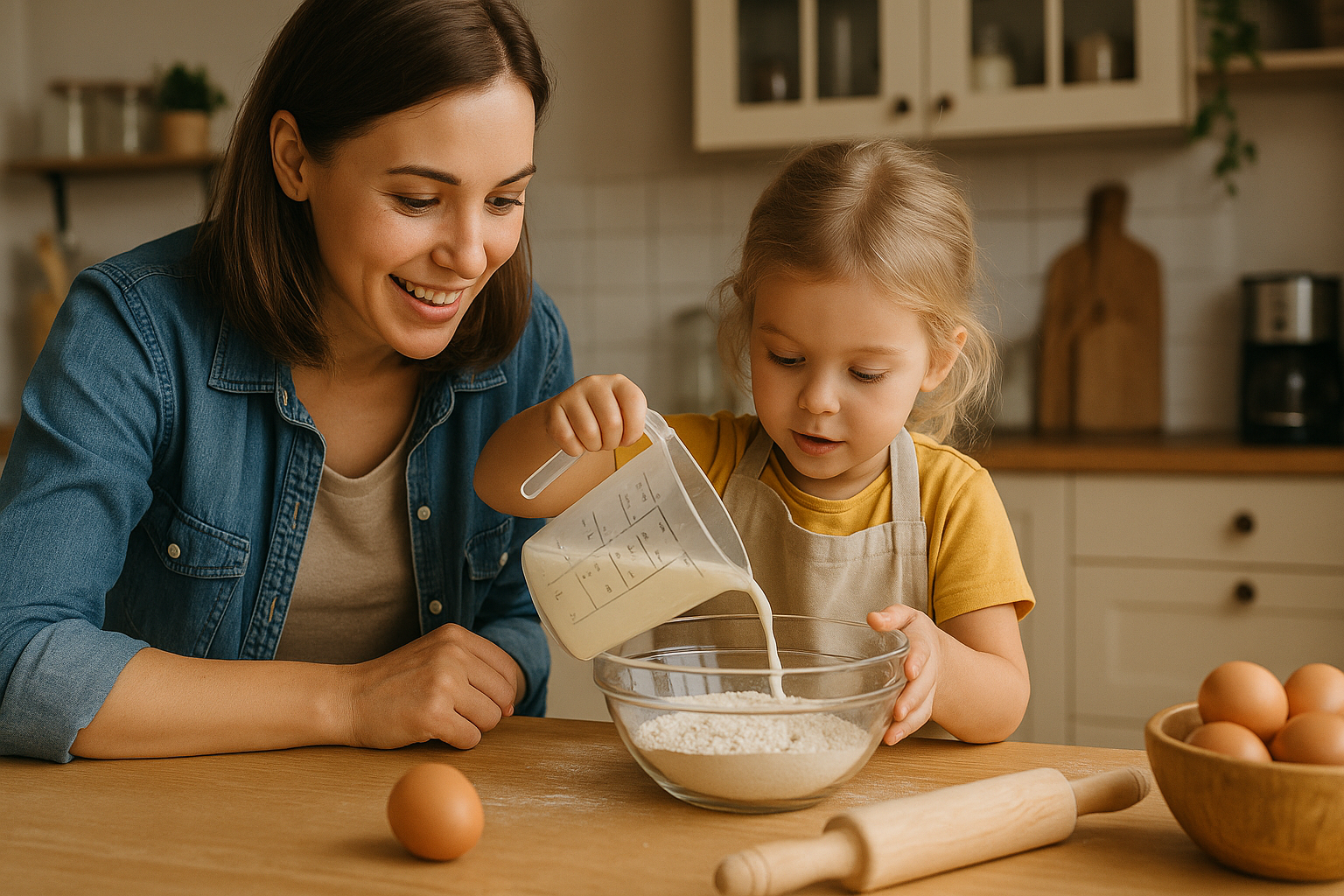The kitchen is more than a place to prepare meals—it’s a dynamic learning environment filled with opportunities for young children to explore, count, measure, observe, and create. With a little intention, everyday kitchen tasks can be transformed into meaningful, hands-on educational experiences for children ages 2 to 6.
In this article, you’ll discover how to turn your kitchen into a space where cooking and learning go hand-in-hand.
Why the Kitchen Is a Powerful Learning Space
The kitchen supports development across multiple domains:
- Language development: Naming ingredients, following instructions.
- Math skills: Counting, measuring, comparing.
- Science exploration: Observing changes in texture, temperature, and states of matter.
- Fine motor skills: Pouring, stirring, peeling.
- Life skills: Responsibility, independence, hygiene.
Plus, the kitchen naturally promotes bonding and cooperation through shared tasks.
Safety First
Before starting, set basic safety rules:
- Wash hands before touching anything.
- Only use plastic or child-safe utensils.
- Always supervise closely—especially near the stove, knives, or hot water.
- Designate a “safe zone” in the kitchen for your child to help.
Learning Activities by Age Group
For Ages 2–3
Toddlers love being part of the action. Keep tasks simple and sensory:
- Pouring: Let them pour dry ingredients into bowls.
- Stirring: Mix batter or sauce with a child-safe spoon.
- Washing produce: Rinse fruits and vegetables in a colander.
- Tearing greens: Help with salad prep by tearing lettuce.
Language tip: Narrate each action. “You’re pouring the flour. It’s white and soft!”
For Ages 4–5
Preschoolers can follow simple steps and instructions:
- Measuring: Use cups and spoons to practice amounts.
- Cracking eggs: With help, let them try cracking into a bowl.
- Spreading: Use a child knife to spread butter or peanut butter.
- Sorting: Group fruit, vegetables, or utensils by size or color.
Math tip: Ask questions like “How many spoons do we need?” or “What’s more: 1/2 or 1?”
Age 6
Older children can participate more independently:
- Reading recipes together
- Chopping soft ingredients (with child-safe knives)
- Creating their own snack ideas
- Setting and clearing the table
Life skill tip: Teach responsibility by assigning a weekly “helper day” in the kitchen.
Everyday Concepts Taught in the Kitchen
1. Math Skills
- Counting eggs, spoons, or cookies
- Comparing sizes of measuring cups
- Estimating quantities: “Is this a little or a lot?”
- Using timers: “Let’s wait 5 minutes”
2. Science Concepts
- What happens when you mix ingredients?
- Why do things rise, melt, or freeze?
- What changes when you cook something?
Encourage curiosity:
“Why do you think the dough is sticky now but soft later?”
3. Language and Literacy
- Learn new words: “whisk,” “grate,” “knead,” “sprinkle”
- Practice sequencing: “First we mix, then we pour.”
- Read labels or recipes together.
You can even create a “recipe book” with your child, using drawings or photos.
4. Social-Emotional Skills
- Working as a team
- Waiting for turns
- Cleaning up together
- Feeling proud of making food for others
Praise their effort:
“You helped make lunch today—that’s so helpful!”
Themed Kitchen Learning Activities
Rainbow Snack
Make a fruit or veggie snack using every color of the rainbow.
Skills: Color recognition, sorting, fine motor coordination.
Muffin Tin Math
Use a muffin tin to count and sort different items—berries, dry pasta, cereal.
Skills: Counting, patterning, number recognition.
DIY Sandwich Bar
Let your child choose ingredients to build their own sandwich.
Skills: Decision-making, independence, sequencing.
Sink or Float with Produce
Fill a bowl of water and test which fruits/vegetables float.
Skills: Scientific prediction and observation.
Cooking with Cultural Stories
Choose a dish from another country and read a story related to it.
Skills: Global awareness, curiosity, open-mindedness.
Turn Clean-Up into a Learning Moment
After the fun, teach the importance of cleaning up:
- Sorting utensils
- Wiping surfaces
- Putting leftovers away
This teaches responsibility and routine, key components of early education.
Kitchen Tools for Young Helpers
Consider having a small drawer or basket with:
- Plastic measuring spoons and cups
- Small whisk or spatula
- Apron and towel
- Cutting board and child-safe knife
- Child-sized bowl and mixing spoon
Having “their own tools” makes children feel capable and included.
Wrapping Up: A Recipe for Learning
Your kitchen isn’t just a place to cook—it’s a place to count, observe, describe, collaborate, and create. When you invite your child into the kitchen with intention, you open up a world of discovery wrapped in love, flour, and laughter.
The next time you’re chopping, stirring, or baking—pause, invite your little one over, and let the learning begin.
